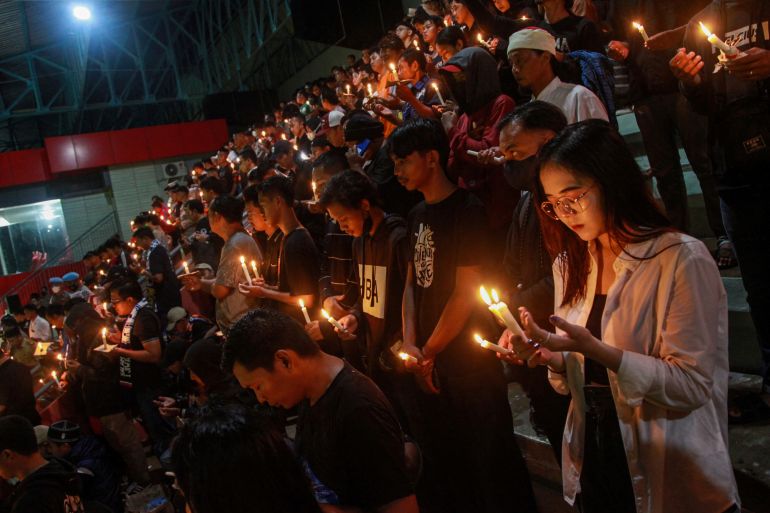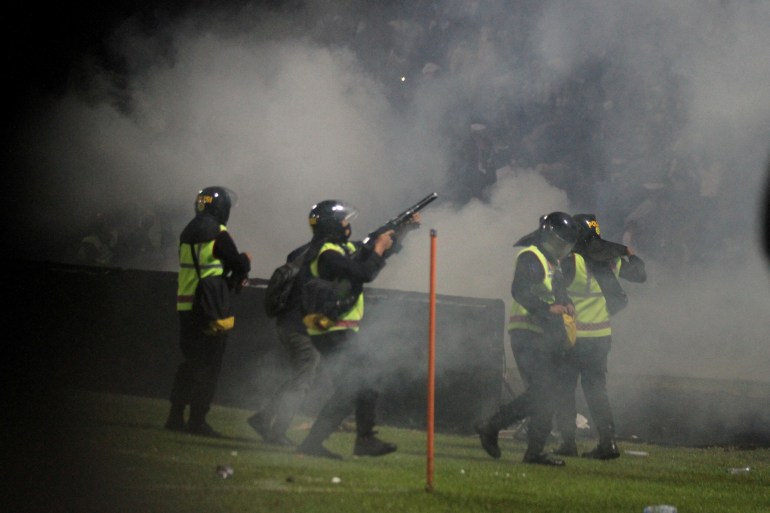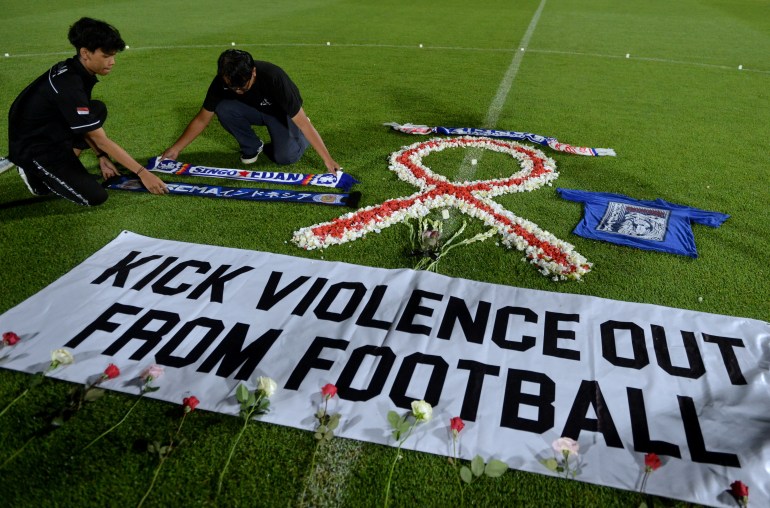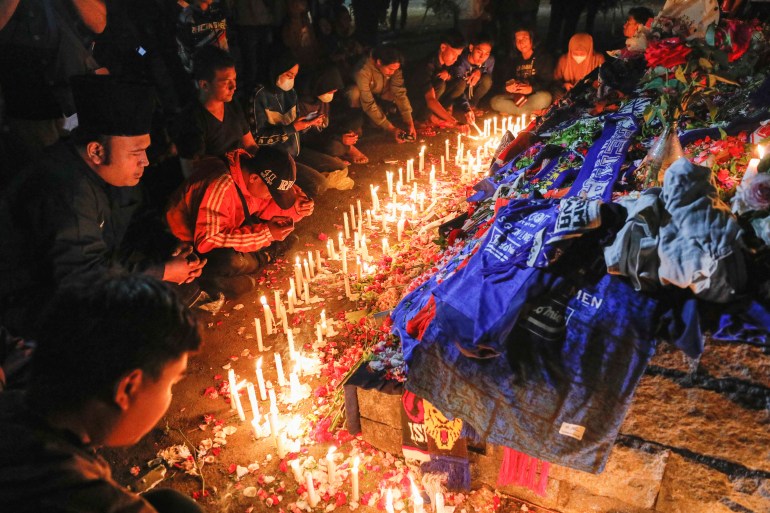Did police cause Indonesia’s football stadium disaster?
A deadly Indonesian football match leads to questions around policing.

An Indonesian football match led to the deaths of more than a hundred people after police fired tear gas. People ran into locked gates while trying to flee the stadium. Now, the government is investigating why the police used tear gas and other forms of excessive force at the game. Indonesians are also reflecting back on the history and might of the country’s police force and how it all culminated in this tragedy.
Keep reading
list of 4 itemsCould Haiti get worse?
How Formula 1 is stepping out on the world stage
After hurricanes, when to rebuild and when to retreat
In this episode:
- Jessica Washington (@JesWashington), Al Jazeera correspondent
- Andreas Harsono (@andreasharsono), Indonesia researcher for Human Rights Watch.
Connect with us:
@AJEPodcasts on Twitter, Instagram, and Facebook
Full episode transcript:
This transcript was created using AI. It’s been reviewed by humans, but it might contain errors. Please let us know if you have any corrections or questions. Our email is TheTake@aljazeera.net.
Halla Mohieddeen: A football match in Indonesia turned deadly.
Newsreel: It’s thought to be the deadliest stadium disaster in more than half a century.
Halla Mohieddeen: Over 100 people died after a stampede at a stadium. The Indonesian government is now investigating whether the national police used excessive force.
Newsreel: Riot police fired tear gas at fans who streamed onto the pitch after a match between two Indonesian teams.
Halla Mohieddeen: But this is not the first time this level of force has been used by the police in Indonesia.
Halla Mohieddeen: What exactly happened that night? And how did it lead to the death of over 100 people? I’m Halla Mohieddeen, and this is The Take.
[THEME MUSIC PLAYING]
Halla Mohieddeen: Al Jazeera correspondent Jessica Washington has been reporting on the stampede. Here’s what happened that night.
Jessica Washington: So there was a football match, quite an ordinary thing…
[SOUNDS OF MATCH]
Jessica Washington: …in Malang in East Java between two local teams – the teams Arema FC and Persebaya Surabaya, so the teams of Surabaya and Malang – on Saturday night. So it was only the fans of the home team that were allowed to attend the match. The fans of the visiting team were actually not allowed to attend the match.
Halla Mohieddeen: This is common practice in Indonesia due to the intensity of football fan culture, Jessica says.
Jessica Washington: So even before anything actually happened, you could see the sort of mechanisms behind the scenes that there was sort of thinking, there might be some conflict between the fans.
Halla Mohieddeen: And what happened next?
Jessica Washington: The home team had lost, and it is only their fans in the stadium. It was considered an unexpected outcome, and it was in the aftermath, the result has become clear. And that’s when we start to see the sort of chaos unfolding.

[MUSIC PLAYING]
[SOUND OF FANS ENTERING FIELD]
Jessica Washington: Some fans in responding to the loss of their team went down onto the field. According to police numbers, there were around 3,000 fans who went onto the field. This is in an audience of around 40,000 spectators. So in what police say was an attempt to disperse the crowds, tear gas was fired by police
[SOUND OF CROWD AFTER TEAR GAS FIRED]
Jessica Washington: And what we know from speaking with spectators is that police not only fired tear gas at the field itself; they also fired it at the stands where people were just sitting down, possibly packing up, getting ready to go home. Suddenly, you’re in this chaotic situation where it’s nighttime. Fans also told us that the lights were dimmed. They couldn’t really see what was happening already because it’s dark. Now there’s this cloud of tear gas covering everything. Suddenly, there’s a mad rush to get to the exits.
Halla Mohieddeen: But many of the 40 exits in the stadium were closed and the gates were locked.
[SOUND OF FANS RUSHING]
Jessica Washington: So you have people rushing, crowding and essentially, trampling over each other because they can’t see where they’re going because they’re choking on tear gas, because their eyes have been affected by tear gas as well. They’re in pain, and they’re just trying to get out. And that is where this tragedy comes from.
Halla Mohieddeen: The current death toll stands at 131, and many more are injured.
Jessica Washington: You know, it’s not about what the fans were doing before. It’s not about fan hooliganism or anything like that. Ultimately, this tragedy comes from the decision to fire tear gas and what happened after.
[MUSIC PLAYING]
Halla Mohieddeen: And what happened after is that people were met with locked gates as they tried to escape the tear gas.
Jessica Washington: What I saw when we were at the stadium are these big metal gates, and you could see that people have pushed their bodies against the gates trying to get out, and you can see how the metal has been warped as they tried to push out. The metal is completely bent out of shape. There was also sort of a ventilation window right next to that exit that had also been smashed. And being there at the stadium, the first thing I noticed when I walked in was this tiny shoe that looked like it belonged to – it was pink and small, looked like maybe a three- or four-year-old girl – that had been squashed flat. And it was brown from being trampled on and purses scattered throughout the stadium. But in the rush to get out, they’d lost their things. And the stairs leading to each of the exit gates, even though the gate was closed, you can still see through sort of a gap and you could see that there are shoes on each step. So, you know, people were running and losing their shoes, and it gives you a sense this was a really chaotic, scary environment to be in. And it, yeah, it’s horrible.
Halla Mohieddeen: You’ve interviewed people who were there. What were they telling you? What stood out to you?
Jessica Washington: The story that stands out to me is we met this father named Andi, and he went to the game with his wife, his two daughters who were teenagers and his two-year-old son.

[MUSIC PLAYING]
Jessica Washington: He explained to us that I thought this would just be a fun outing with my family, something nice for us to do. I never anticipated that something would happen. In the end, he, what happened was the tear gas was fired.
Andi (translated): My wife told me to keep him safe. She told me to take him first.
Jessica Washington: His wife, he said, the last thing she said to him was, we’ll take care of the baby, so the two-year-old, and I’ll look after the girls.
Andi (translated): The most important thing was to save him. I threw him down from the stands. I asked people to catch him. Then I jumped down to get him, and I ran to find a medic.
Jessica Washington: Ultimately, by the time he is able, he’s looking for his daughters and his wife, you know, because they’ve been split up in the chaos and he has no idea where they are. He can’t reach them.
Andi (translated): After the situation calmed down, I went to look for my wife and children. I found my daughters around midnight. I found my wife at 1:30 at night. They were already dead.
[MUSIC PLAYING]
Jessica Washington: So his story is one that stands out, but everyone is grieving in this community in their, in their own way. There were, of course, you know, hundreds of people who were injured, and so we were at the hospitals. There were around eight hospitals that were treating people who were injured. Just there was this hospital waiting room with parents with the most anxious faces you could imagine just waiting for updates on their children, waiting to know if they’re okay or not.
Halla Mohieddeen: That must have been incredibly hard, Jessica. I mean, how did that affect you reporting on this? Because I’m listening to these stories, I’ve got chills. I mean, this feels like it’s going to haunt me, and I’m thousands of miles away. How did that make you feel as you were, as, as you were listening to this?
Jessica Washington: I mean, yeah, it’s such a good question. Probably I hope I’ll never see something like this again in my lifetime. And it was horrific. And just seeing these young people, just like shaking and, you know, imagining what it’s like to be a teenager going through that. I mean it’s extremely tragic, and I’m still kind of processing what we saw.
Halla Mohieddeen: Jessica said that days after the event, many survivors returned to the stadium, hoping to tell their story to reporters.
Jessica Washington: I think part of wanting to come back is that they themselves wanted to see the scene. But secondly, I think, they wanted to make sure that this didn’t become a misrepresented story of the fans – they were up to no good – because you know, in part there is that challenge of Indonesian football fans having somewhat of a bad reputation, so they are sort of the easy targets. And I think they wanted to come and make sure that, hey, I want to tell you what I saw. So that was them wanting to share what they witnessed because only the fans know what happened that night.
[MUSIC PLAYING]
Jessica Washington: And I did see some online commentary of people saying things like, oh, but you know, these football fans, if they hadn’t caused trouble in the first place, none of this would’ve happened. But that’s not true. Maybe there were some people engaging in antisocial behaviour. That doesn’t mean that you gas 40,000 people when actually FIFA regulation stipulates that using tear gas is prohibited full stop. So there are many questions. Why was tear gas brought in the first place, and then why was it fired at the stands? Why was it fired at all?
[MUSIC PLAYING]
Halla Mohieddeen: We’ll talk more about those questions and find some answers after the break.
Halla Mohieddeen: What happened at the Kanjuruhan Stadium in Malang is not an isolated incident. Police have used tear gas at football games before in Indonesia. That is something that many residents know well.
Andreas Harsono: I live just five minutes walk from the largest stadium in Indonesia.
Halla Mohieddeen: This is Andreas Harsono. He covers Indonesia for Human Rights Watch.
Andreas Harsono: This is the largest one in Indonesia, meaning that every weekend, I’m familiar with football matches, and I often smell tear gas in the neighbourhood every time I pass around the stadium.
[MUSIC PLAYING] Halla Mohieddeen: Andreas has covered the police for many years. He says that this level of brutality is common, but often aimed at certain groups more than others.
Andreas Harsono: If you are rich, you know, the police will be reluctant to use excessive force against you. If you are highly educated, the police might think twice against you, or if you are a man, it’s different than how the police treat a woman or treat a lesbian or a gay man, moreover, a transgender. Last but not the least, if you have dark skin, you are more likely to face excessive use of force than if you have lighter skin. And of course, if you are well dressed. It is different than if you wear a football T-shirt or football jersey or football bandanas. It is different.
Halla Mohieddeen: And he says that this prejudice is part of the reason that the level of brutality happens at Kanjuruhan Stadium.
Andreas Harsono: The victims, they are common people. Of course, there are elite who watch football, but they are in the VIP balconies. Those that die inside the stadium are people who are commoners, common people.

[MUSIC PLAYING]
Andreas Harsono: It should be a cheerful game, you know? Oh, goal! Shouting, that kind of thing, you know, to burst out emotion at least once a week or once a month. Those are the people who mostly die in the stampede.
Halla Mohieddeen: The Indonesian police’s ability to do this, says Andreas, is because of their might, which matches that of the country’s military. This happened after the dictatorship under President Suharto in the late 1990s.
Andreas Harsono: They have almost equal sizes of forces. In terms of budget per personnel, it is roughly equal. The police also have their own boats, ships, planes, choppers, armoured personnel carriers. But the police, this is very important. The police have this BRIMOB unit. All over Indonesia, every province has a paramilitary unit.
Halla Mohieddeen: And this unit is a large reason that the police are able to use excessive force.
Andreas Harsono: The issue with the BRIMOB unit is it is a unit of the police, but it functions more like a military unit. It is not a policing unit. It is a defence unit.
Halla Mohieddeen: BRIMOB is considered a special unit, and it is often dispatched for riot control.
Andreas Harsono: Just the approach is less civilian, more militaristic. Those are the units that operated inside the stadium that night.
Halla Mohieddeen: And to both Andreas and Jessica, this power of the police is something that’s been building up, leading to the tragedy at Kanjuruhan Stadium.
Jessica Washington: This incident was sort of the horrific formula, combination of tear gas being fired, the gates being locked, and, you know, the timing of the event as well. So you had sort of all factors culminating in a particularly horrific situation.
Halla Mohieddeen: Well, Jessica, it sounds like the police have a history of doing this. What has the government response been?
Jessica Washington: That’s sort of the problem, I guess, that in the past where there have been these instances of – whether by police misconduct or negligence or violence against civilians – that the response has often been seen as inadequate, that it’s left to police to sort of investigate themselves, and human rights groups like Human Rights Watch, Amnesty International, have consistently raised that as being a problem.
[MUSIC PLAYING]
Jessica Washington: With regard to this specific incident, we have sort of several streams of investigations. There is an investigation that is a multidisciplinary group of journalists, ministers, that is led by the chief security minister. That investigation is, of course, crucial and they will ultimately pass their findings down directly to the president.
Halla Mohieddeen: This is what Indonesian President Joko Widodo had to say.
Joko Widodo (translated): I have ordered a full audit of all stadia and buildings to fix exits, gates and positions of seats, gates and everything else, so that audience safety and supporter safety is prioritised. That is all I can say.
Halla Mohieddeen: For Andreas from Human Rights Watch, the investigation involves more than just the police.
Andreas Harsono: We are talking about coordination between the police and also the military, which was helping the police at the time. If you look at the videos, you can see many army men were also inside the stadium, kicking, hitting football fans. And then the football association, we are talking about three institutions now.
Halla Mohieddeen: FIFA has recently announced that they will not place sanctions on Indonesia. However, it is still awaiting the results of the investigation to see if Indonesia can hold games safely.
Jessica Washington: This tragedy has come at a time where Indonesia is actually looking to increase its standing on the global football scene. So next year, Indonesia is hosting the under-20s FIFA tournament. It’s actually considered quite a big deal for Indonesia. It’s their first FIFA tournament. And so when this tragedy happened, the immediate question was, is that going to be taken away?

[MUSIC PLAYING]
Jessica Washington: Immediately there are questions. Is Indonesia capable of having a sporting event like this safely? The latest that we’ve heard is that the Indonesian president has directly been speaking with FIFA, an attempt to reassure them that this can go ahead safely.
Joko Widodo (translated): When I spoke on the phone with the president of FIFA, Gianni Infantino, he conveyed that FIFA is ready to help fix our football management. I believe we need a full evaluation of everything, management of stadia, management of matches, management of audiences, management of time, management of safety. Everything needs to be entirely evaluated.
Jessica Washington: Basically the solution is that FIFA is going to set up office here in Indonesia, where they can sort of help with some of their safety challenges and perhaps be a more sort of on-the-ground presence.
Halla Mohieddeen: So do you think then that there will be some kind of change that will happen when it comes to police behaviour because that’s quite the carrot to dangle in front of Indonesia’s police force? Could this lead to change?
Jessica Washington: You know, that’s really the question that everyone is asking. That’s what the survivors are asking. It’s what loved ones of those who were killed in this tragedy are asking. Will there be anything meaningful as an outcome from this? And, you know, it’s left to be seen where we’re already seeing some sort of outcomes of the investigation. They’ve already said, yes, the use of tear gas is the main problem. And you know, that report already looks like it is going into horrific detail about survivors having shortness of breath and coughing. So having that sort of testimony from survivors in the report, you would hope that that is powerful and compelling and compels Indonesia to do something about this problem. But so far, we’re seeing in the investigation that six suspects have been named and among them are three policemen. It’s difficult to say whether this will lead to long-term change for policing in Indonesia itself.
Halla Mohieddeen: But Andreas says that real change in Indonesia may take more time.

[MUSIC PLAYING]
Andreas Harsono: I have seen decades of violence in Indonesia. I have witnessed killings. I have seen dead bodies enough in the nearly four decades of my work as a human rights researcher, as a journalist. I do not expect reform to take place soon in Indonesia. But what we can do is hope for smaller steps to be taken. I will be lucky if some small step is taken before my time has passed. But I, as an Indonesian, I have hope that the future of Indonesia, at least for my children’s generation, will be much better.
Halla Mohieddeen: And that’s The Take. This episode was produced by Chloe K. Li with Negin Owliaei, Alexandra Locke, Ashish Malhotra, Amy Walters, Ruby Zaman and me, Halla Mohieddeen. Our sound designer is Alex Roldan. Tim St. Clair mixed this episode. Aya Elmileik and Adam Abou-Gad are our engagement producers. Ney Alvarez is our head of audio. We’ll be back on Monday.
Episode credits:
This episode was produced by Chloe K. Li with Negin Owliaei and our host, Halla Mohieddeen. Ruby Zaman fact-checked this episode. Tim St. Clair mixed this episode. Our production team includes Chloe K. Li, Alexandra Locke, Ashish Malhotra, Negin Owliaei, Amy Walters, and Ruby Zaman. Our sound designer is Alex Roldan. Aya Elmileik and Adam Abou-Gad are our engagement producers. Ney Alvarez is Al Jazeera’s head of audio.